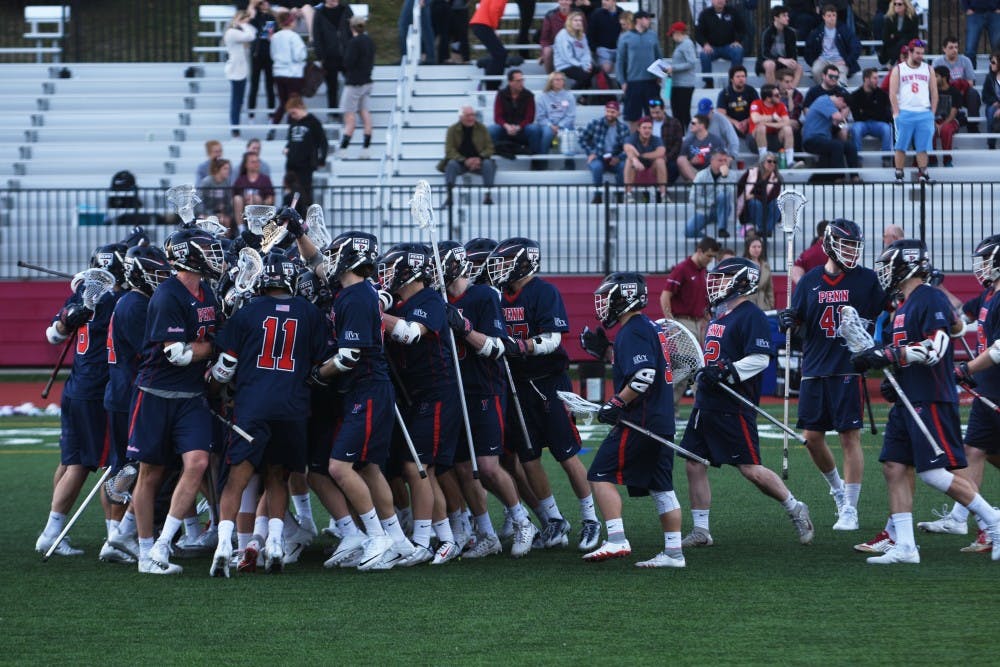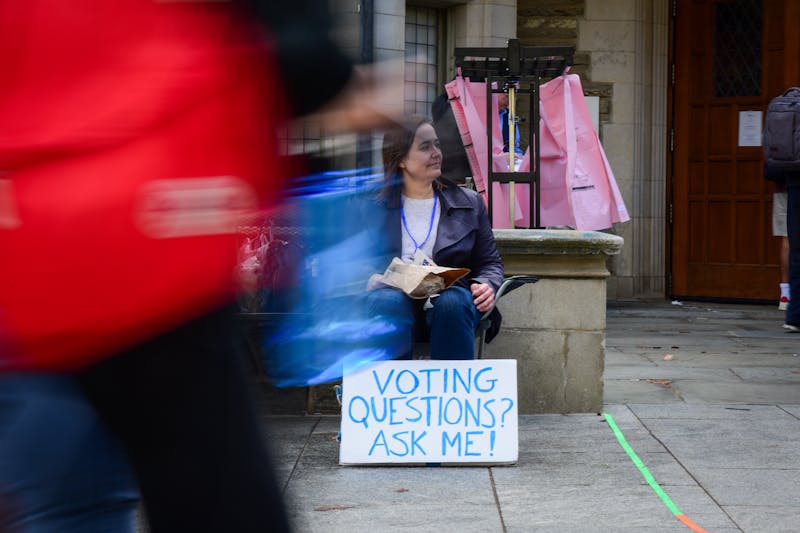
Returning a plethora of talent to a team that came oh-so-close to Ivy League supremacy last season, it's time for Penn men's lacrosse to finally make the leap, Brevin Flesicher argues.
Credit: Pranay VemulamadaDon’t sleep on Penn men’s lacrosse.
That’s not just a message to the students here at Penn or even to the team’s rivals in the Ivy League. That’s a message to all of college lacrosse.
Not convinced? Here’s five reasons why:
One: The Ivy League is undeniably one of the best lacrosse conferences in the country.
For many of the high profile college sports across the nation, the Ivy League is considered a mid-major conference. The teams it produces are typically solid but rarely national title contenders. Whether it be in basketball, football, baseball, or softball, it’s highly unlikely for an Ivy squad to be among the nation’s elite.
However, this pattern does not extend to lacrosse, the sport in which the conference has boasted nine national titles over its history and three Tewaaraton Award winners (the Heisman Trophy of lacrosse) in the past eight years. Just last year, two of the Tewaaraton finalists hailed from the Ancient Eight, including the award’s recipient, Dylan Molloy of Brown.
Every Ivy game is consequential on the national scale. Last season, Brown advanced all the way to the Final Four, and Yale held the No. 1 ranking in the country for multiple weeks. Had one of those two teams not won the Ivy League tournament, many analysts suggested that the conference would have had three bids in the 16-team NCAA bracket.
So when it comes to men’s lacrosse, the Ivy League is kind of a big deal.
Two: Penn was one of the best teams in the Ivy League last year.
Despite a relatively rocky season in which Penn was heavily reliant on freshman scoring, the Red and Blue were able to earn a spot in the Ivy League tournament last year as the No. 3 seed. The Quakers drew a matchup with a highly-ranked Yale team that was sporting a shiny 11-2 record at the time. The battle that ensued proved to be an epic clash of defenses, which Yale won by a single goal. The Bulldogs would then go on to win the Ivy League title with relative ease two days later, supporting the notion that Penn was among the league’s elite.
Three: The two teams in front of Penn last year lost many of their key pieces.
Brown and Yale were undoubtedly the two best teams in the Ivy League last year. Even the biggest Penn homer in the world would have to concede that point. However, assuming that the 2017 Brown and Yale teams will seamlessly replicate last year’s success is ludicrous.
Let’s start with Brown. The Bears, fresh off their NCAA semifinal appearance from last year, return the nation’s top player in Molloy, but it can be argued that they have lost their most important piece. Head coach Lars Tiffany left his alma mater for the greener pastures of Charlottesville to become the head coach of Virginia in a move that sent shockwaves across the lacrosse world. Tiffany was the man who implemented the fast tempo, run-and-gun style of play that made Brown so fun and effective last spring. To rub salt in the wound, Tiffany brought his prized offensive coordinator Sean Kirwan with him as well as the rest of his staff, leaving Brown scrambling to rebuild.
Unfortunately for Brown, the rebuilding process is not limited to the coaching staff. Although Brown brings back star players such as Alec Tulett, Larken Kemp, and Molloy, first team All-American goalie Jack Kelly has graduated. Additionally, the Bears will be looking to replace an astounding 292 points from last year’s senior class, as the five leading scorers on the team not named Molloy were all seniors. As Brown could very well learn this year, players like Henry Blynn and Kylor Bellistri don’t grow on trees.
Now on to Yale. As is the case with Brown, the Bulldogs retain their star player from last year. Junior Ben Reeves is among the most dynamic attackmen in the game. As such, he has garnered significant Tewaaraton hype this season after coming up just short of the award last year. However, in an unfortunate turn of events for the entire lacrosse community, the star scorer went down in Yale’s opening game against Villanova and did not return to action. The extent of his injury is yet to be reported, but any missed time for Reeves would be devastating for Yale.
Regardless of Reeves’ availability, Yale will have to replace valuable players from their star-studded 2016 roster. first team All-American Michael Quinn was not just arguably the best defenseman in the country last year, but he was also an indispensable emotional leader for Yale. The toughness he displayed playing through a torn ACL against Navy in the first round of the postseason last year won’t soon be forgotten by anybody who watched that game. Beyond Quinn, the Bulldogs will have to replace All-American midfielder Michael Keasey, an explosive player capable of taking over a game at any time.
Depending on the severity of Reeves’ injury, it may seem to the casual observer that these losses are normal, cyclical occurrences that won’t have an overbearing impact on Yale’s overall play, but when you look at what Penn has to replace from last year’s team, the gravity of Yale’s losses is quite apparent.
Four: Penn returns everybody
Do you remember reading earlier that Brown has lost 292 points from its senior class? Do you remember thinking that that statistic was meaningless because you didn’t have anything to compare it to? Well, here it is. The Quakers will look to replace 61 points from last year’s seniors. That’s right. 61 points. That’s about a fifth of the production that Brown will have to replace. Even crazier is the fact that those 61 points came from just two players, Nick Doktor and Pat Berkery.
Accompanying Doktor at attack last year were then-freshmen Simon Mathias and Alex Roesner. The two young players performed admirably in their roles, earning the starting spots for this season as well. Mathias, in particular, quickly established himself as one of the top players in the conference, garnering Ivy League Rookie of the Year honors, an award that he shared with fellow Penn freshman Reed Junkin, the team’s goalie.
However, Penn’s returning star power doesn’t rest solely with the current sophomore class. Aiding Junkin’s efforts on the defensive end will be three senior defensemen, all of whom started last year. Those three defensemen — Kevin Gayhardt, Kevin McDonough, and Eric Persky — will look to build off of the impressive season they put together last year when they held high-scoring teams such as Yale and Penn State under ten goals.
Finally, and perhaps most importantly for Penn, first team All-Ivy selection and preseason All-American Connor Keating returns to Franklin Field for his junior season. Keating registered 17 points from the defensive end last year, establishing himself as one of the best long stick midfielders in the nation.
All in all, Penn returns five of its six leading point producers from last year, as well all three of its starting defensemen and its starting goalie. That should scare the rest of the Ivy League.
Five: Penn has the potential to be the best in the Ivy League this year.
This one is pretty much just common sense when you put points two, three, and four together.
The Quakers were third in the Ivy League last year. They lost to the Ivy League champion by a single goal both of the times they played, and they bring back almost all of their starters. The two teams ahead of Penn last year have lost enormous amounts of talent and, depending on Reeves’ injury, could lose even more.
The Ivy League is officially Penn’s for the taking this year. The team just has to go out and grab it.
Conclusion: Penn could very well make a run towards Championship Weekend this year.
Think about it. Penn might be the best team in one of the best conferences in the country. That typically translates to national championship aspirations. Last season, Brown occupied that very same role and found itself playing on Memorial Day weekend with everything on the line. That could be Penn this year.
The talent is there. The conference is wide open. This is Penn’s shot.
The Daily Pennsylvanian is an independent, student-run newspaper. Please consider making a donation to support the coverage that shapes the University. Your generosity ensures a future of strong journalism at Penn.
Donate






